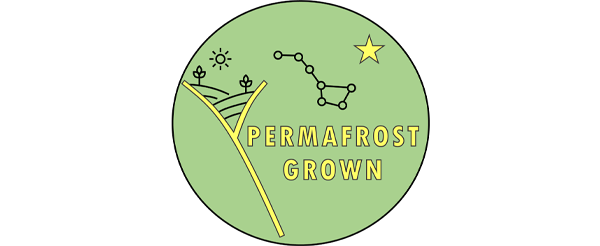Here we explore Dr. Melissa Ward Jones’ research on permafrost systems in the continuous permafrost zone of the Arctic and permafrost-agriculture interactions primarily in the discontinuous permafrost zone of Alaska
Melissa Ward Jones is a Research Assistant Professor in the Water and Environmental Research Center at the University of Alaska Fairbanks. She completed her B.Sc. (2012), M.Sc. (2016) and Ph.D. (2020) in the Department of Geography at McGill University, Canada. Melissa is a permafrost scientist and geographer interested in the causes (system components such as climate and land cover) and system responses (e.g., thaw subsidence) of permafrost landscapes.
Her work focuses on permafrost systems in the continuous permafrost zone of the Arctic and permafrost-agriculture interactions primarily in the discontinuous permafrost zone of Alaska.
She utilizes a mixed-methods approach to her research, combining field observations and measurements, sensor networks, remote sensing, GIS, statistical analysis and more recently, surveys and interviews.
Melissa has extensive field experience, including remote winter and summer camping, and has completed over 15 arctic field expeditions in places such as Axel Heiberg and Ellesmere Islands, Canada, Svalbard, Norway, and throughout Alaska, USA. Melissa is an advocate for making science and fieldwork more family-friendly and has been doing fieldwork with her daughter since her daughter was two months old.
Melissa has worked with Arctic logistic companies to increase access to housing and transportation opportunities for researchers with childcare responsibilities during fieldwork. Recently, she championed the creation of the US Permafrost Association Family Care Program, launched in 2024 to provide caregiver grants to permafrost researchers.
The Permafrost Grown Project
Melissa Ward Jones leads the Permafrost Grown Project, a five year, 3 USD million project funded by the US National Science Foundation. This project is composed of over 25 people, bringing together a research team from the University of Alaska Fairbanks and local Alaskan farmers based in the Tanana Valley (Interior Alaska), Bethel (southwest Alaska) and Anaktuvuk Pass (Arctic Alaska).
This transdisciplinary project utilizes a variety of methods, including a sensor network to monitor ground and weather conditions, agricultural experiments, satellite-, airborne- and drone-based remote sensing, ground penetrating radar, ground drilling, tree coring, soil surveys, economic modelling, surveys, interviews, and workshops to meet project objectives.
The Permafrost Grown Project objectives:
- To better understand the interaction and feedback between permafrost and agriculture,
- To understand legacy effects of cultivation over the last ~120 years,
- Evaluate socio-economic tradeoffs and provide decision-making tools,
- Provide education and outreach materials and activities to advance public and farmer knowledge.
Permafrost Grown is generating knowledge and creating resources to increase food security and economic resiliency in Alaska.
Arctic, Antarctic, and Alpine Research Editors’ Choice Award
*The following text was taken from the Arctic, Antarctic, and Alpine Research Editors’ Choice Award webpage and can be accessed here.
The 2024 Editors’ Choice Award honors the paper: “Socioecological dynamics of diverse global permafrost-agroecosystems under environmental change”by Melissa Ward Jones et al. in Arctic, Antarctic, and Alpine Research 56(1).
The article presents a global synthesis of permafrost-agroecosystems done by the International Permafrost Association permafrost-agroecosystem action group. Agricultural activities in permafrost dominated regions include horticulture, grain cultivation, floriculture, and animal husbandry (including mobile pastoralism) on arable permafrost-affected soils. The study highlighted countries where permafrost-agroecosystems are most prominent, demonstrated linkages between agriculture, environmental change (particularly permafrost thaw), livelihoods, regional economies/policies, and discussed public perceptions of environmental change.
Using an analysis of agricultural datasets and permafrost modeling, the authors estimated which countries were likely to have the largest area of permafrost-agroecosystems and selected seven regional case studies. By examining various forms of crop cultivation, animal husbandry and pastoralism, hay production, berry picking, and reindeer herding, the case studies revealed the complex socioecological interactions, ecosystem and land use tradeoffs, and knowledge gaps that need to be addressed to sustainably manage and develop locally relevant, climate-positive permafrost-agroecosystems. In Alaska, for example, the first agricultural research stations that were established in 1898 included two in permafrost areas and in the 1950s regional agriculture provided half of the state’s food supply. While the reliance on regional agriculture in Alaska declined subsequently, it is now rebounding and may accelerate permafrost thaw.
This paper is a significant contribution to AAAR’s collection “Arctic and Alpine Social-Ecological Systems: Sustainability and Resilience,”which showcases research that addresses the biophysical and social underpinnings of ecosystem services and ways to support sustainability in polar, subarctic, and alpine regions.
Resources and further reading
- Ward Jones, M. K., Schwoerer, T., Gannon, G., Jones, B. M., Kanevskiy, M. Z., Sutton, I., St. Pierre, B., St. Pierre, C., Russell, J., and Russell, D. (2022). Climate-driven expansion of northern agriculture must consider permafrost. Nature Climate Change, 12, 699-703. https://doi.org/10.1038/s41558-022-01436-z.
- Ward Jones, M., and Bendixen, M. (2022). It’s time to make science in remote places family friendly. Nature. https://doi.org/10.1038/d41586-022-02048-5.
- Ward Jones, M. (2023). Assessing Ice Wedge Micro-Topography Interactions with Environmental Parameters in Alaska through Family Friendly Science. Witness Community Highlights. Arctic Consortium of the United States (ARCUS). Access: https://www.arcus.org/witness-the-arctic/2023/8/highlight/1


